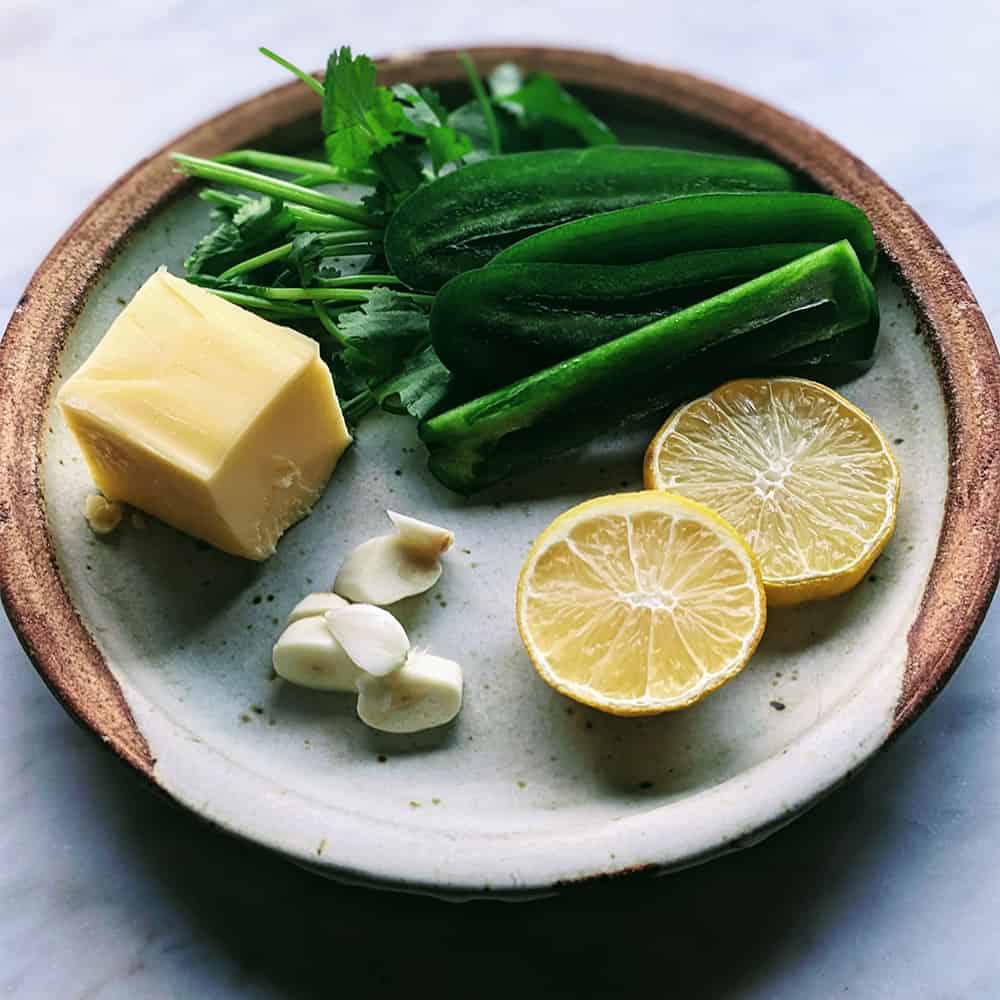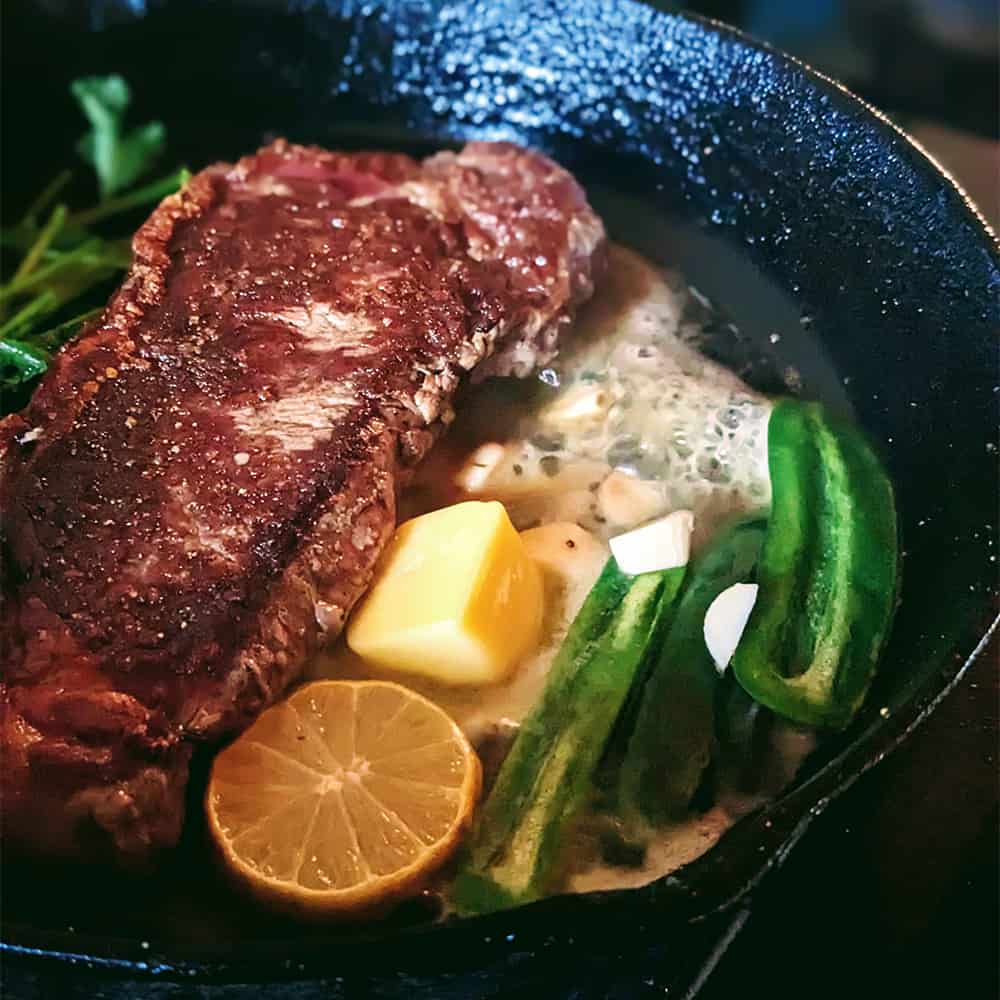Even though our grills might be covered for the season, we can still make mouth-watering, perfectly cooked and seasoned steaks indoors. Today, I am going to walk you through my favorite way to cook a steak indoors. I first learned to properly cook a steak when cooking at The Peninsula Hotel in Chicago under the tutelage of Chef Graham Elliot. We were a small team of four cooks working five nights a week in the hotel’s fine dining restaurant inside the workings of a large hotel kitchen. Our open kitchen was small, with a dining bar allowing guests a front-row seat to watch us cook. We each worked a station on our own (garde manger, hot apps, butcher, and saucier) for three months, after which time we would rotate around to another station. When working as the butcher, not only was it our responsibility to break down fish and other cuts of meat on the menu, during service we cooked every piece of meat that left the kitchen, from 3-course to 21-course tasting menus per guest. To get the job done we had a four-gas burner range and a small convection oven which we kept at 500 F. the entire night. There was no grill or wood-burning oven, but I soon learned that all I needed was right in front of me: a large soup spoon (never tongs), a few well-seasoned cast iron pans, salt, my trust pepper grinder, a high smoke point oil, butter, and aromatics.
In this recipe you’ll notice that the aromatics I use are lemon, cilantro stems, jalapeno and garlic. This is just one out of an almost infinite number of variations you could try. Use the herbs and flavors that work for you. If you have sage or lavender in the garden, try it! Normally I tend to use thyme, rosemary, garlic and lemon. But on this night, I used what I had (leftover cilantro and jalapenos from taco night earlier in the week) and it ended up being one of the best pan-seared steaks I have ever made. The important thing to remember when choosing aromatics is that they need to be carefully dried after being washed. Natural juice from a lemon, lime, or piece of ginger isn’t a big deal, but you never want to add water to a pan with hot oil, as it will result in dangerous splattering and possible burns.
At first glance, this method might appear too easy for a whole recipe’s worth of attention, but let me assure you. It’s the best way of cooking a steak I’ve ever come across. Aside from maybe the Japanese three-crust method which I’ll save for grilling season since it requires an open flame. Because this recipe is mostly about a method or technique, I would especially recommend reading the entire method in advance.
And this technique isn’t only for steak. Over the years I have found myself using this method for fish, chicken, all kinds of red meats, even cauliflower steak. When it comes to beef though, choosing a good quality porterhouse, beef tenderloin, filet mignon, t-bone, strip or rump steak are good choices.
PrintPan-Seared Steak Method
This method will teach you how to cook a mouth-watering pan-seared steak indoors in a cast iron pan. When I don’t have a grill, this is hands down my favorite technique for cooking a well-seasoned steak.
- Prep Time: 15 mins
- Cook Time: 15 mins
- Total Time: 30 minutes
- Yield: 2 servings
- Category: Dinner
- Method: sear
- Cuisine: American
Ingredients
- 1 large steak, 1-1 1/2 inch thick
- salt and pepper
- 1/2 t. neutral oil with a high smoke point (grapeseed, avocado, vegetable, sunflower)
- 2 T. butter
- 1/2 lemon, sliced
- 1 small handful of cilantro stems
- 2 jalapenos, sliced
- 3 garlic cloves, sliced
Instructions
First, dry the steak with a paper towel and let it come to room temperature so it can cook evenly and retain its juices. This will take anywhere from 10-30 minutes depending on the temperature of your kitchen as well as the size of the steak.
Now, season the steak generously on both sides with salt and pepper. Place a cast iron or other heavy-bottomed pan over medium-high heat and add the oil. When you can see the oil ripple as you gently tip the pan to one side, you know the pan is hot enough (do not put the steak into a cold pan). Gently place the steak in the pan and let it sear where it is (resisting the temptation to move it around) for around 3 minutes. If you want to help it along, carefully press down on the steak with the back of a spoon to create more pressure as it’s searing which will create even more caramelization in the flavor-filled crust. Turn the steak over and repeat this process so both sides get a good sear.

At this point, turn the heat to medium and add the butter, lemon, cilantro stems, jalapeno, and garlic. With your spoon, move the steak toward the top of the pan and move the aromatics to the side or on top of the steak. Carefully tip the pan towards you while it’s still over the heat, being careful no butter spills out, and spoon the sizzling butter over the steak, again and again, to finish cooking the steak. This will probably take anywhere from 30 seconds to 2 minutes, depending on the thickness of the steak and how well done you prefer it to be cooked.

You can certainly take the temperature of the steak with a thermometer to find your perfect cook (rare: 125 F. | medium-rare: 130-135 F. | medium: 135-140 F. | medium-well: 140-150 F. | well: 155 F.) by inserting the thermometer into the thickest part of the steak. But I prefer and recommend the poke-with-your-finger method. Not only does it teach you to just know when a steak is done, but I find it to be more accurate during the fast pace reality of cooking. You feel it with your finger, take it off at the perfect time, and boom it’s done and ready for resting.
The Finger Test
The best way I have found to learn the poke method is to use your very own hand as a guide. The first step is to touch your ring finger to your thumb and turn your hand so the palm is facing you. If you press on your hand just below your thumb this will mimic what it feels like when you poke a well-done steak. Move your finger slightly to the left around your thumb and you will feel what a medium-well steak feels like. Keep working your way around your thumb and you will eventually reach what a rare steak feels like. Use this method as long as you need to learn and then the day will come when you’ll know everything you need to know with a single poke of your finger.
Once the steak is cooked to your preferred temperature, transfer the steak and all the aromatics to a shallow bowl (so as not to lose any of the juices) and loosely cover it with foil for 5-10 minutes before serving so the inside juices can redistribute and don’t just spill out once the steak is cut with a knife.




